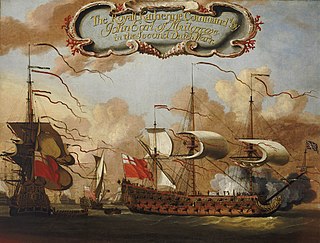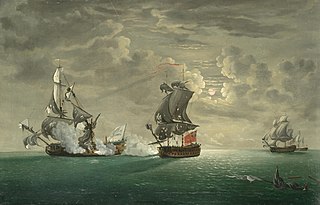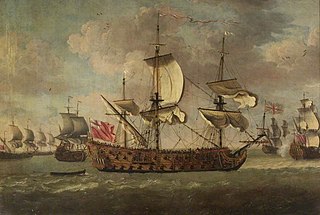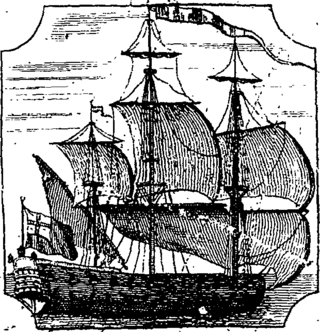| History | |
|---|---|
| | |
| Name | President |
| Builder | Peter Pett I, Deptford Dockyard |
| Launched | 1650 |
| Renamed | HMS Bonaventure, 1660 |
| Fate | Broken up in 1711 |
| General characteristics as built [1] | |
| Class and type | 38-gun fourth rate frigate |
| Tons burthen | 462 (bm) |
| Length | 100 ft (30.5 m) (keel) |
| Beam | 29 ft 6 in (9.0 m) |
| Depth of hold | 12 ft 8 in (3.9 m) |
| Propulsion | Sails |
| Sail plan | Full-rigged ship |
| Armament | 38 guns (1660); 48 guns (1677) |
| General characteristics after 1683 rebuild [2] | |
| Class and type | 40-gun fourth rate ship of the line |
| Tons burthen | 550 bm |
| Length | 124 ft 10 in (38.0 m) (gundeck) |
| Beam | 31 ft 10 in (9.7 m) |
| Depth of hold | 12 ft 6 in (3.8 m) |
| Propulsion | Sails |
| Sail plan | Full-rigged ship |
| Armament | 40 guns of various weights of shot |
| General characteristics after 1699 rebuild [3] | |
| Class and type | 46-54-gun fourth rate ship of the line |
| Tons burthen | 597 (bm) |
| Length | 125 ft 5 in (38.2 m) (gundeck) |
| Beam | 33 ft 1+1⁄2 in (10.1 m) |
| Depth of hold | 12 ft 5 in (3.8 m) |
| Propulsion | Sails |
| Sail plan | Full-rigged ship |
| Armament | 46-54 guns of various weights of shot |
| General characteristics after 1711 rebuild [4] | |
| Class and type | 1706 Establishment 50-gun fourth rate ship of the line |
| Tons burthen | 703 bm |
| Length | 130 ft (39.6 m) (gundeck) |
| Beam | 35 ft (10.7 m) |
| Depth of hold | 14 ft (4.3 m) |
| Propulsion | Sails |
| Sail plan | Full-rigged ship |
| Armament | |
| General characteristics after 1722 rebuild [5] | |
| Class and type | 1719 Establishment 50-gun fourth rate ship of the line |
| Tons burthen | 764 (bm) |
| Length | 134 ft (40.8 m) (gundeck) |
| Beam | 36 ft (11.0 m) |
| Depth of hold | 15 ft 2 in (4.6 m) |
| Propulsion | Sails |
| Sail plan | Full-rigged ship |
| Armament |
|
President was a 38-gun fourth rate frigate of the Royal Navy, originally built for the navy of the Commonwealth of England by Peter Pett I at Deptford Dockyard, and launched in 1650. [1]
After the Restoration in 1660, she was renamed HMS Bonaventure after a previous ship built in 1653 that had been blown up three years later. [6] She took part in the Battle of Dover in 1652 during the First Anglo-Dutch War. She was widened in 1663, and by 1677 her armament had been increased to 48 guns. [1] In 1683 she underwent her first rebuild, relaunching as a 40-gun fourth rate ship of the line. [2] Bonaventure was rebuilt a second time in 1699 at Woolwich Dockyard, relaunching as a fourth rate of between 46 and 54 guns. [3] Her third rebuild took place at Chatham Dockyard, where she was rebuilt as a 50-gun fourth rate to the 1706 Establishment, relaunching on 19 September 1711. She was renamed HMS Argyll prior to the Jacobite rising of 1715, [4] and on 27 January 1720 she was ordered to be taken to pieces at Woolwich for what was to be her final rebuild.

She was relaunched as a 50-gun fourth rate to the 1719 Establishment on 5 July 1722, [5] and saw much service in home and Atlantic waters. She was employed on blockade duties during the War of the Austrian Succession, and in 1741 Argyll captured five Spanish coasters, and with the assistance of two other warships cut free five captured British warships that were docked in north-western Spain.
In 1742 Argyll served to escort convoys of East Indiamen from St. Helena to England. [7] In 1745 she returned to Britain by way of escorting a convoy and was paid off in 1746. After the conclusion of the war in 1748, Argyll was towed to Harwich and scuttled as part of a breakwater. [5]










